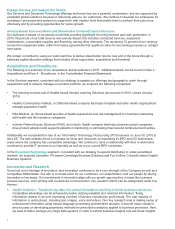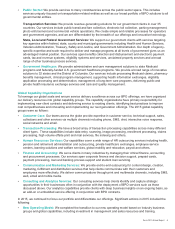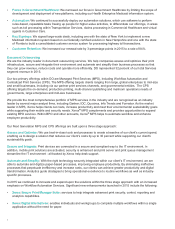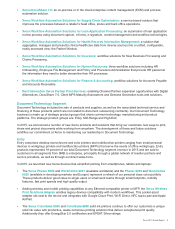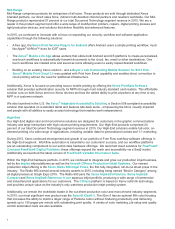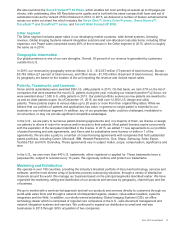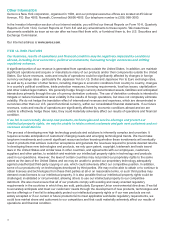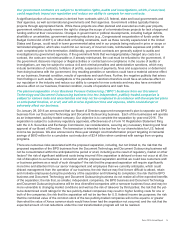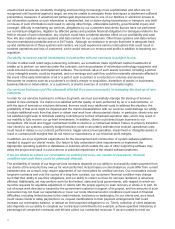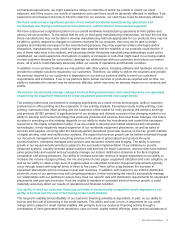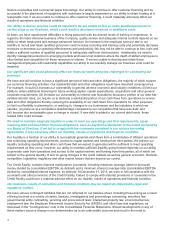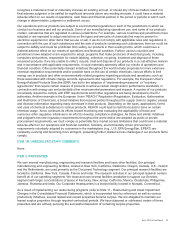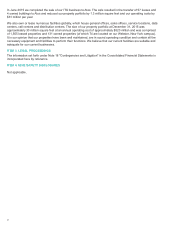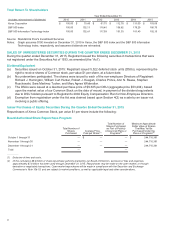Xerox 2015 Annual Report Download - page 30
Download and view the complete annual report
Please find page 30 of the 2015 Xerox annual report below. You can navigate through the pages in the report by either clicking on the pages listed below, or by using the keyword search tool below to find specific information within the annual report.Other Information
Xerox is a New York corporation, organized in 1906, and our principal executive offices are located at 45 Glover
Avenue, P.O. Box 4505, Norwalk, Connecticut 06856-4505. Our telephone number is (203) 968-3000.
In the Investor Information section of our Internet website, you will find our Annual Reports on Form 10-K, Quarterly
Reports on Form 10-Q, Current Reports on Form 8-K and any amendments to these reports. We make these
documents available as soon as we can after we have filed them with, or furnished them to, the U.S. Securities and
Exchange Commission.
Our Internet address is www.xerox.com.
ITEM 1A. RISK FACTORS
Our business, results of operations and financial condition may be negatively impacted by conditions
abroad, including local economics, political environments, fluctuating foreign currencies and shifting
regulatory schemes.
A significant portion of our revenue is generated from operations outside the United States. In addition, we maintain
significant operations and acquire or manufacture many of our products and/or their components outside the United
States. Our future revenues, costs and results of operations could be significantly affected by changes in foreign
currency exchange rates - particularly the Japanese Yen to U.S. Dollar and Japanese Yen to Euro exchange rates,
as well as by a number of other factors, including changes in economic conditions from country to country, changes
in a country's political conditions, trade protection measures, licensing requirements, local tax issues, capitalization
and other related legal matters. We generally hedge foreign currency denominated assets, liabilities and anticipated
transactions primarily through the use of currency derivative contracts. The use of derivative contracts is intended to
mitigate or reduce transactional level volatility in the results of foreign operations, but does not completely eliminate
volatility. We do not hedge the translation effect of international revenues and expenses, which are denominated in
currencies other than our U.S. parent functional currency, within our consolidated financial statements. If our future
revenues, costs and results of operations are significantly affected by economic conditions abroad and we are
unable to effectively hedge these risks, they could materially adversely affect our results of operations and financial
condition.
If we fail to successfully develop new products, technologies and service offerings and protect our
intellectual property rights, we may be unable to retain current customers and gain new customers and our
revenues would decline.
The process of developing new high technology products and solutions is inherently complex and uncertain. It
requires accurate anticipation of customers' changing needs and emerging technological trends. We must make
long-term investments and commit significant resources before knowing whether these investments will eventually
result in products that achieve customer acceptance and generate the revenues required to provide desired returns.
In developing these new technologies and products, we rely upon patent, copyright, trademark and trade secret
laws in the United States and similar laws in other countries, and agreements with our employees, customers,
suppliers and other parties, to establish and maintain our intellectual property rights in technology and products
used in our operations. However, the laws of certain countries may not protect our proprietary rights to the same
extent as the laws of the United States and we may be unable to protect our proprietary technology adequately
against unauthorized third-party copying or use, which could adversely affect our competitive position. In addition,
some of our products rely on technologies developed by third parties. We may not be able to obtain or to continue to
obtain licenses and technologies from these third parties at all or on reasonable terms, or such third parties may
demand cross-licenses to our intellectual property. It is also possible that our intellectual property rights could be
challenged, invalidated or circumvented, allowing others to use our intellectual property to our competitive
detriment. We also must ensure that all of our products comply with existing and newly enacted regulatory
requirements in the countries in which they are sold, particularly European Union environmental directives. If we fail
to accurately anticipate and meet our customers' needs through the development of new products, technologies and
service offerings or if we fail to adequately protect our intellectual property rights or if our new products are not
widely accepted or if our current or future products fail to meet applicable worldwide regulatory requirements, we
could lose market share and customers to our competitors and that could materially adversely affect our results of
operations and financial condition.
13


